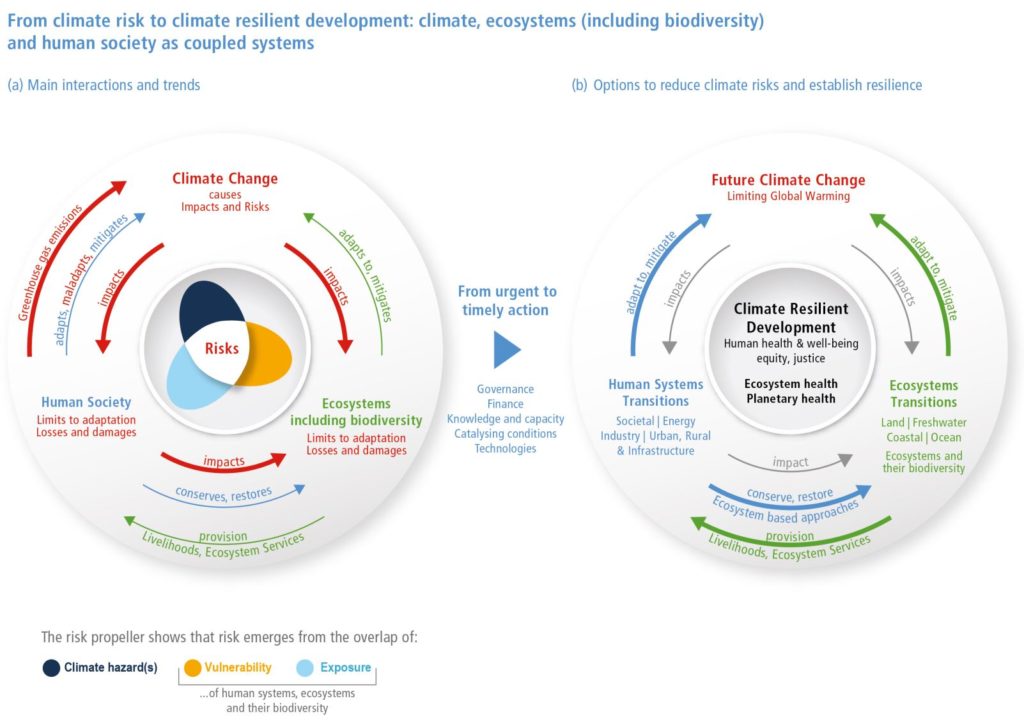The cumulative scientific evidence is unequivocal: Climate change is a threat to human well-being and planetary health. Any further delay in concerted anticipatory global action on adaptation and mitigation
will miss a brief and rapidly closing window of opportunity to secure a liveable and sustainable future for all. (very high confidence)

This report recognizes the interdependence of climate, ecosystems, biodiversity, and human societies
(Figure SPM.1) and integrates knowledge more strongly across the natural, ecological, social, and economic
sciences than earlier IPCC assessments. The assessment of climate change impacts and risks as well as
adaptation is set against concurrently unfolding non-climatic global trends e.g., biodiversity loss, overall
unsustainable consumption of natural resources, land and ecosystem degradation, rapid urbanization, human
demographic shifts, social and economic inequalities, and a pandemic.
The scientific evidence for each key finding is found in the 18 chapters of the underlying report and in the 7
cross-chapter papers as well as the integrated synthesis presented in the Technical Summary (hereafter TS)
and referred to in curly brackets {}. Based on scientific understanding, key findings can be formulated as
statements of fact or associated with an assessed level of confidence using the IPCC calibrated language. The
WGII Global to Regional Atlas (Annex I) facilitates the exploration of key synthesis findings across the WGII
regions.
The concept of risk is central to all three AR6 Working Groups. A risk framing and the concepts of adaptation,
vulnerability, exposure, resilience, equity and justice, and transformation provide an alternative, overlapping,
complementary, and widely used entry points to the literature assessed in this WGII report.
Across all three AR6 working groups, risk provides a framework for understanding the increasingly severe,
interconnected, and often irreversible impacts of climate change on ecosystems, biodiversity, and human
systems; differing impacts across regions, sectors, and communities; and how to best reduce adverse consequences for current and future generations. In the context of climate change, risk can arise from the
dynamic interactions among climate-related hazards6 (see Working Group I), the exposure, and vulnerability of affected human and ecological systems. The risk that can be introduced by human responses to climate change is a new aspect considered in the risk concept. This report identifies 127 key risks. {1.3,
16.5}




40 Comments
Pingback: buy shipping container uk
Pingback: เครื่องฉีดพลาสติก
Pingback: weed for sale,
Pingback: pg betflik
Pingback: car towing near me
Pingback: SEO Affiliate Domination
Pingback: slot gacor
Pingback: dark168
Pingback: car detailing
Pingback: thai massage denver
Pingback: แนะนำเกมสล็อตแตกบ่อย KA Gaming Slots
Pingback: Jaxx Liberty
Pingback: แพคเกจทัวร์
Pingback: Juad Slot88 ฝากถอนไว
Pingback: Food Recipes
Pingback: watch now
Pingback: cinemakick
Pingback: ufa168
Pingback: Medical1
Pingback: ร้านแว่นสายตา
Pingback: อยากเริ่มต้นธุรกิจ นำเข้าสินค้าจากจีน
Pingback: สิ่งที่คอบอลต้องรู้ก่อนแทงบอล
Pingback: Big Bass Splash
Pingback: bgame777
Pingback: lotto888
Pingback: เติมเกม
Pingback: รับทำใบอนุญาต
Pingback: เว็บตรง อันดับ 1
Pingback: Michelle
Pingback: แทงบอลมันนี่ไลน์ ผ่านเว็บตรง LSM99
Pingback: Investor Relations หรือ นักลงทุนสัมพันธ์
Pingback: Blub
Pingback: Mostbet
Pingback: เว็บตรงฝากถอนง่าย
Pingback: indoor spielplatz holland
Pingback: สล็อต 1688 เว็บตรง วอเลท
Pingback: lucky jet
Pingback: 7slots
Pingback: ชิปปิ้ง
Pingback: ufabet789